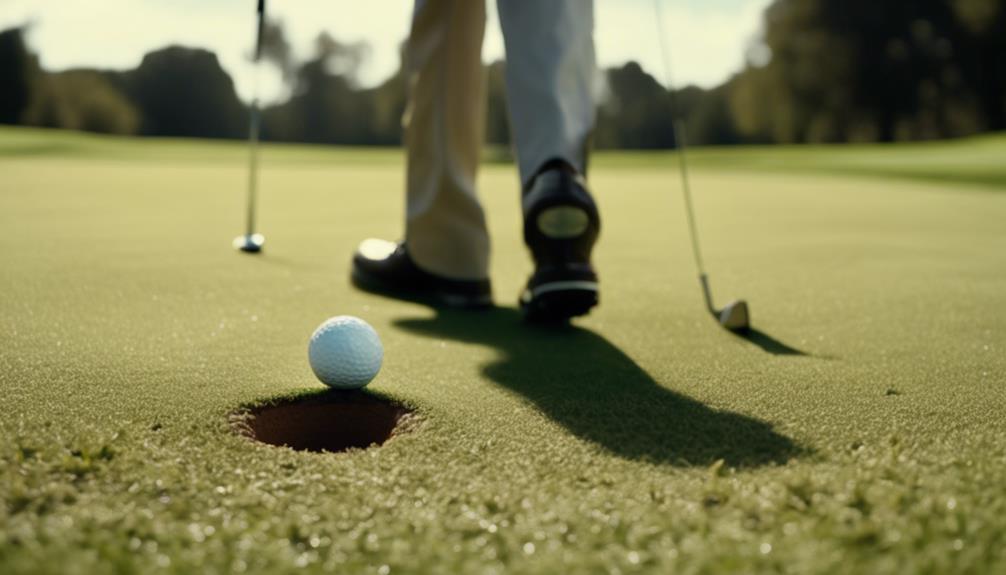- 7 Top Flite Golf Clubs XL for Improved Performance - September 28, 2024
- Top Flite Golf Clubs: Top 5 Reasons to Choose Them - September 28, 2024
- Top 3 Golf Club Fitters for a Perfect Swing - September 28, 2024
As a beginner, selecting the right LW golf club can be intimidating, but understanding the basics is fundamental. You'll want to contemplate a pitching wedge, gap wedge, and sand wedge as essentials, with a 60-degree lob wedge recommended for versatility. Proper setup and configuration are vital, with a focus on loft angles and distance control. By mastering short game strategy and avoiding common mistakes, you'll be well on your way to improving your score. Now, take the next step in revealing your short game potential by discovering the best LW golf club configuration for your unique needs and swing style.
Key Takeaways
- A 60-degree lob wedge is recommended for beginners due to its versatility and forgiveness in various short game situations.
- Mastering the lob wedge requires practice with different swing lengths and ball positions to develop feel and precision.
- Choosing the right lob wedge involves considering loft, grind, and weight to match individual swing mechanics and course conditions.
- Beginners should focus on developing a consistent chipping technique and practicing with alignment sticks to improve accuracy and control.
Understanding Wedge Basics
When it comes to tackling short game shots, understanding the basics of wedges is essential, as these specialty clubs are designed to help you navigate tight lies, bunkers, and tricky distances with precision and control.
You'll find that wedges come in four main categories: pitching wedge, gap wedge, sand wedge, and lob wedge, each with increasing loft angles ranging from 42 to 64 degrees.
The pitching wedge, typically part of your iron set, has a loft of 42-47 degrees and is perfect for full-swing shots and short chips.
The gap wedge, with a loft between 49-53 degrees, fills the distance gap between the pitching and sand wedges, making it ideal for precise full swings and greenside shots.
As you move towards the higher-lofted wedges, you'll find the lob wedge, usually around 60 degrees loft, is specifically designed for high, short shots and flop shots, providing versatility for tricky short distances.
Understanding these basics will help you choose the right wedge for the job and improve your short game.
Choosing the Right Lob Wedge
You'll want to carefully select a lob wedge that suits your game, as this high-lofted club is designed to help you navigate the most delicate and demanding short shots around the green. A lob wedge with the right loft, grind, and feel can make all the difference in your short game. Here's what to contemplate:
| Loft | Grind | Use Case |
|---|---|---|
| 58° | Narrow | Tight lies, precise control |
| 60° | Medium | General short game, balance of versatility and ease of use |
| 62° | Wide | Soft lies, high-flopping shots |
| 64° | Extra Wide | Extremely soft lies, extreme flop shots |
| Custom | Custom | Tailored to your specific swing and short game needs |
As a beginner, a 60-degree lob wedge is a great starting point, offering a balance of versatility and ease of use for various short game situations. Remember to practice with your lob wedge to develop feel and control, as this club can be less forgiving and requires precision in execution. By choosing the right lob wedge and practicing with it, you'll be well on your way to mastering the short game.
Wedge Setup and Configuration

Your LW Golf Club setup should include a thoughtfully configured wedge system, featuring a mix of clubs that work together seamlessly to help you tackle various short game challenges.
As a beginner, it's vital to carry at least a pitching wedge and a sand wedge, with the pitching wedge lofted between 42-47 degrees and the sand wedge between 54-57 degrees. Consider adding a gap wedge, lofted between 49-53 degrees, to fill the distance gap between the two and enhance your short game versatility.
When configuring your wedge setup, space your clubs by 3-6 degrees in loft to manage distance control effectively and provide a variety of shot options around the green.
Regularly evaluate your wedge setup based on course conditions and personal play style to improve performance and scoring.
Mastering Short Game Strategy
As you move on to mastering short game strategy, it's crucial to choose the right wedge for the job and develop a solid understanding of when to use it.
You'll need to take into account factors like loft, distance, and swing technique to become a short game master.
Wedge Selection Essentials
Mastering the short game requires a well-thought-out wedge selection strategy, and for beginners, carrying the right combination of wedges is vital to improving performance around the greens.
As you start building your short game skills, remember that selecting the right wedges is important. You should aim to carry at least a pitching wedge and a sand wedge to cover various shot types within 100 yards.
Here are three key considerations for your wedge selection:
- Fill the distance gap: A gap wedge is important for filling the distance gap between your pitching wedge and sand wedge, providing ideal versatility for approach shots and greenside chipping.
- Refine your loft configuration: Aim for a loft configuration of around 45° for pitching wedges, 50° for gap wedges, and 56° for sand wedges to guarantee proper distance management and shot variety.
Short Game Mastery
You'll greatly improve your scoring by developing a solid short game strategy that incorporates specific distances for each wedge. With your LW Golf Club, focus on mastering shots within 100 yards of the pin. Aim to execute 2-3 different shots per club, such as flop shots and delicate chips, to enhance your versatility and confidence.
Don't forget to practice with your gap wedge (GW) in conjunction with your lob wedge to fill essential distance gaps, improving accuracy and shot selection from 150 yards and in. Regularly evaluate and adjust your wedge setups based on course conditions and personal performance to refine your short game mastery.
This will lead to significant improvements in your overall scoring. As you develop your short game strategy, remember to stay adaptable and adjust your approach according to the situation. With consistent practice and refinement, you'll be well on your way to achieving short game mastery and taking your game to the next level.
Gap Wedge Vs Lob Wedge

When you're deciding between a gap wedge and a lob wedge, you'll want to contemplate the loft options that suit your game.
You'll need to think about the distance control strategies that'll help you navigate those tricky shots around the green.
Wedge Loft Options
Between the pitching wedge and sand wedge, an essential decision awaits: choosing the right loft option, namely the gap wedge or lob wedge, in order to fill the distance gap in your short game arsenal.
As a beginner, you'll want to evaluate the wedge loft options that best suit your game. The gap wedge, with its loft ranging from 49 to 53 degrees, is ideal for shots from about 95 to 110 yards. On the other hand, the lob wedge, with a loft between 58 to 64 degrees, is designed for high, short shots such as flop shots and delicate chips around the green.
When deciding between the two, weigh the following:
- Your skill level: If you're a beginner, a gap wedge might be a better option, offering more forgiveness and ease of use.
- Your shot-making preferences: If you're comfortable with spin and trajectory control, a lob wedge might be more suitable for creative shot-making.
Distance Control Strategies
Mastering distance control with gap and lob wedges is essential for beginners, as it allows you to tackle various short game scenarios with confidence. To develop a solid understanding of distance control, it's vital to understand the distinct roles of each wedge. Gap wedges, with their loft range of 49-53 degrees, are ideal for full swings and shots around 100 yards, making them perfect for approach shots. Lob wedges, on the other hand, with lofts between 58-64 degrees, are designed for shorter, higher shots and require more precision.
Here's a breakdown of how to effectively use each wedge for distance control:
| Wedge | Loft Range | Ideal Distance | Usage |
|---|---|---|---|
| Gap Wedge | 49-53° | 90-100 yards | Approach shots, full swings |
| Gap Wedge | 49-53° | 80-90 yards | Slightly shorter approach shots |
| Lob Wedge | 58-64° | 70-80 yards | Delicate, high-arc shots |
| Lob Wedge | 58-64° | 60-70 yards | Very short, high-arc shots |
Distance Management With LW
By experimenting with varying swing lengths and techniques, you can release the lob wedge's distance management capabilities, achieving distinct yardages that will help you tackle shots from 60-80 yards with confidence.
To master distance management with your lob wedge, focus on developing a consistent pre-shot routine and practice hitting shots at different distances. This will help you gauge the club's capabilities and develop a better sense of how far it will travel based on your swing.
Here are three key takeaways to keep in mind:
- Adjust your swing length: Choking up on the grip or using a shorter backswing can help control the distance and trajectory of your shots.
- Experiment with different techniques: Try out different swing styles, such as a more compact swing or a fuller swing, to achieve varying distances.
Common Mistakes to Avoid

As you continue to develop your skills with the lob wedge, it's equally important to recognize and avoid common mistakes that can hinder your progress and undermine your confidence.
One mistake to avoid is underestimating the importance of proper loft selection, which can lead to poor shot execution. Remember, a lob wedge typically has a loft ranging from 58 to 64 degrees, making it challenging to master without adequate practice.
Another mistake is neglecting to practice partial swings with your LW, essential for managing short distances and improving accuracy around the greens. Don't use your lob wedge too frequently for longer shots; instead, utilize lower-lofted clubs to avoid excessive swing errors and inconsistent results.
Understand the differences between a lob wedge and other wedges to make informed shot selections. The lob wedge is best suited for high, soft landing shots, not general approach shots.
Practice Drills for Improvement
Now that you've mastered the basics, it's time to take your LW game to the next level with practice drills that'll improve your short game fundamentals.
You'll want to focus on consistent swing practice to develop muscle memory and fine-tune your technique.
Short Game Fundamentals
Mastering short game fundamentals is key to shaving strokes off your score, and it all starts with developing a consistent chipping technique using your lob wedge (LW).
To improve your short game, focus on practicing with your LW to enhance control and accuracy for short shots around the green. Aim for a target area rather than the hole, as this will help you develop a more precise approach.
Here are three practice drills to help you improve your short game fundamentals:
- Clock Drill: Place balls at various distances around the green and practice chip shots with your LW, varying your swing length and tempo to improve distance control.
- Ladder Drill: Set up targets at different distances and practice hitting each target with your LW, helping to develop feel and precision for varying shot lengths.
Consistent Swing Practice
To take your short game to the next level, focus on consistent swing practice with your lob wedge, which will help you develop muscle memory and improve your overall technique.
Set specific goals for each practice session, such as achieving a certain number of successful shots, to enhance your focus and motivation.
Incorporate drills like 'half swings' to focus on controlling the clubface and improving accuracy. Using alignment sticks during practice will guarantee proper swing path and body alignment, essential for consistent contact with the ball.
Recording your swings on video provides visual feedback, allowing you to analyze your form and make necessary adjustments to enhance your lob wedge technique.
Regularly practice different types of shots, such as flop shots and delicate chips, to build versatility and confidence in your short game.
Distance Control Drills
Your ability to control distance with your lob wedge is essential for hitting precise shots around the greens, and practicing with specific drills can greatly improve your skills.
To take your game to the next level, focus on developing a consistent swing length for each target distance. Try hitting shots at 30, 50, and 70 yards, and experiment with half swings, three-quarter swings, and full swings to develop a feel for how each swing length affects ball distance.
Here are three key drills to help you master distance control with your LW Golf Club:
- Target Practice: Set up alignment sticks or markers on the practice green to create specific targets, allowing for precise distance management during wedge shots.
- Ball Position Experimentation: Try placing the ball forward in your stance for a higher launch and backward for a lower launch, observing how it affects distance and trajectory control with the LW.
Selecting the Best LW for You

When you're searching for the perfect lob wedge, reflect on your game's specific needs and preferences to find the ideal match. A lob wedge with a loft between 58-64 degrees is a great starting point, with 60 degrees being the most versatile choice for short game shots.
As a beginner, you'll want to look for a LW with a wider sole, which provides more forgiveness and prevents digging into the ground, especially in tricky lies around the greens. The grind of the lob wedge is also essential, as it affects how it interacts with the turf.
Choose a design that suits your typical course conditions, whether it's firm or soft. Don't forget to reflect on the weight and feel of the LW, as comfort and confidence are key to executing effective short game shots.
Taking Your Short Game Further
Mastering the lob wedge reveals a new dimension of precision and creativity in your short game, allowing you to tackle tricky lies and tight pin placements with confidence.
With your LW Golf Club, you'll be able to take your short game to the next level by developing a reliable and consistent swing.
Here are three key areas to focus on to improve your short game with a lob wedge:
- Practice flop shots and delicate chips: Regularly practice using your LW for high, short shots over obstacles and delicate chips around the greens to improve your versatility and confidence in scoring scenarios.
- Map distances and develop control: Regularly map distances with your lob wedge, such as achieving consistent carries of 30-50 yards, to enhance your shot accuracy and control.
Frequently Asked Questions
What Is an Lw Golf Club?
You're considering a golf club that helps with high, short shots? An LW, or lob wedge, is a versatile club with a 58-64 degree loft, ideal for flop shots and delicate approaches, requiring precise lob wedge techniques when choosing the right one for your game.
What Is the Difference Between PW AW SW and Lw?
'Imagine maneuvering a treacherous obstacle course; you need the right tools. In golf, that means mastering pitching techniques with the right club selection. PW, AW, SW, and LW each serve a unique purpose, with varying lofts and uses to conquer different distances and terrains.'
Do I Really Need a Lob Wedge?
You don't necessarily need a lob wedge, but it offers benefits like high, soft shots and delicate chips. When choosing wedges, consider your short game skills, course conditions, and whether a gap wedge might be a better fit for your needs.
Is a Lob Wedge the Same as a Gap Wedge?
Think of your golf game like a recipe: a lob wedge is the special ingredient for delicate, high-arcing shots, while a gap wedge is the reliable staple for consistent, mid-range approaches – they're not interchangeable, and each serves a unique purpose.
Conclusion
As you wrap up your journey to mastering the LW golf club, remember that practice is key.
Your short game is like a recipe, and the LW is the secret ingredient that takes it from bland to grand.
With the right setup, strategy, and mindset, you'll be chipping like a pro in no time.
Keep working on your craft, and you'll be sinking birdies like a hot knife through butter.




